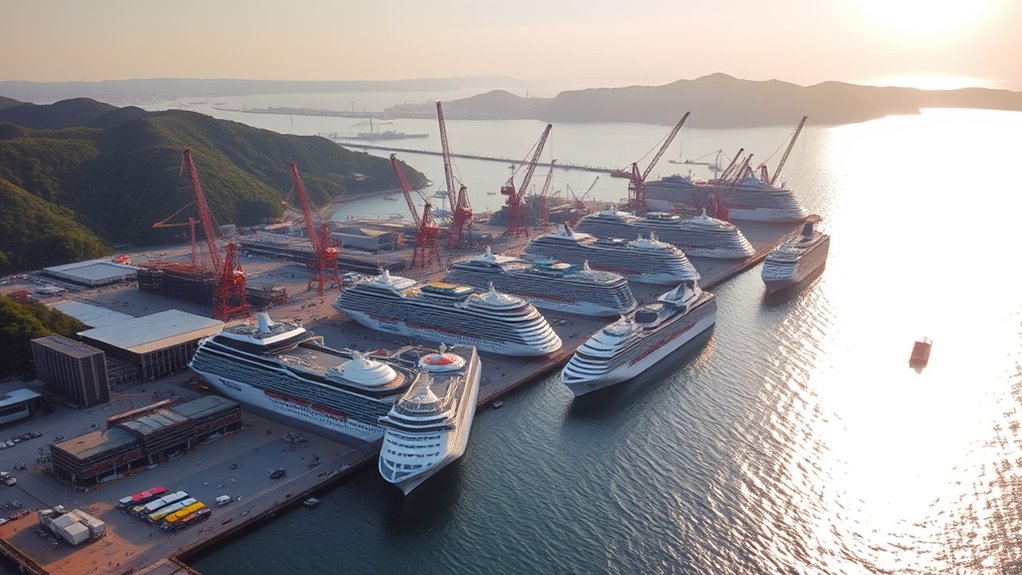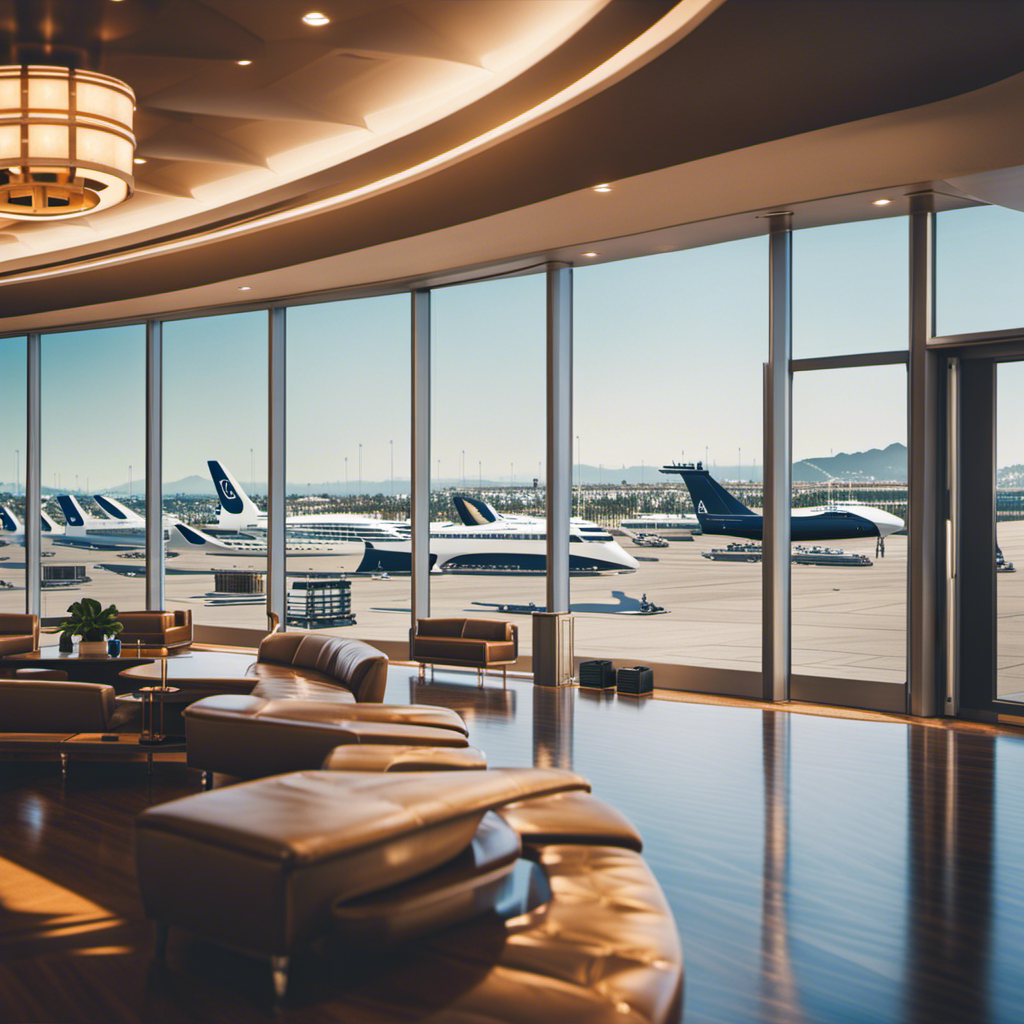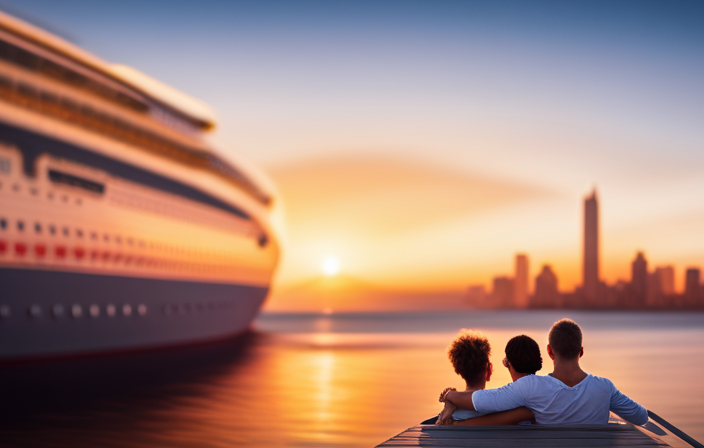Cruise ports are rapidly expanding with major upgrades and new terminal projects, especially at Galveston and San Juan, supporting larger ships and increased passenger flows. Industry-wide, fleets are growing with hundreds of thousands of new berths, boosting capacity and economic impact. Ports are investing billions in infrastructure to improve safety, efficiency, and sustainability. If you keep exploring, you’ll discover how these developments are shaping the future of cruise travel worldwide.
Key Takeaways
- Major ports like Port Canaveral are expanding terminals, including a $500 million upgrade to support larger ships and increased passenger capacity.
- San Juan Cruise Port is progressing on a $425 million modernization project, with over 15% of work completed to enhance infrastructure and safety.
- The Port of Galveston anticipates over 400 sailings and 1.75 million passengers in 2025, supported by infrastructure improvements.
- Feasibility studies for new cruise terminals, such as Cruise Terminal 10, are underway, with updates expected by mid-2025.
- Ports worldwide are investing billions in modernization, capacity expansion, and sustainable infrastructure to support growing cruise industry demands.
Growth and Expansion at the Port of Galveston

The Port of Galveston is experiencing remarkable growth and expansion, driven by record passenger volumes and increased cruise activity. In 2024, more than 3.4 million cruise passengers sailed from the port, supporting over 380 sailings across three terminals. The port hit a major milestone on December 6, 2024, welcoming its 1.5 millionth cruise passenger. Nearly 1.5 million travelers commenced on 354 cruises that year, setting new records. Looking ahead, projections for 2025 include over 400 sailings and approximately 1.75 million passengers. This surge reflects the port’s essential role as a regional cruise hub, serving areas within a 300-mile radius, including Houston, Austin, Dallas, Oklahoma City, and Little Rock. The growth signifies a thriving industry that continues to shape Galveston’s economic future. This expansion underscores the importance of port infrastructure improvements and capacity enhancements to accommodate increasing demand. Additionally, ongoing investments in port infrastructure are critical to supporting this growth trajectory. Recognizing the importance of sustainable development, the port is also exploring eco-friendly initiatives to minimize environmental impact while accommodating continued growth. Furthermore, the port’s ability to adapt with advanced technology ensures smoother operations and improved passenger experience amid rising volumes.
New Cruise Terminal Projects and Infrastructure Upgrades

As cruise activity continues to grow at ports like Galveston, plans for new terminals and upgrades are gaining momentum to support larger ships and increased passenger flow. At Port Canaveral, the expansion of Cruise Terminal 5 will increase capacity by 65%, allowing for bigger vessels and more travelers. Exterior upgrades at Cruise Terminal 1, starting in May 2025, will include new canopies and landscaping to enhance passenger experience. Antigua is constructing a new state-of-the-art cruise terminal at its fifth berth, creating jobs and boosting tourism. Meanwhile, Buffalo is requesting proposals to build a new cruise terminal at the Outer Harbor for both domestic and international travelers. These projects, combined with infrastructure enhancements like berthing for ships up to 1,200 feet, aim to modernize facilities and support future growth. Incorporating industry transformations such as AI automation and innovative logistics solutions can further optimize port operations and passenger services. Additionally, ongoing investments in port infrastructure are essential to accommodate the increasing cruise traffic and ensure competitive advantages in the industry. Implementing modernization strategies can facilitate more efficient operations and enhance overall port competitiveness.
Fleet Developments and Capacity Increases in 2025
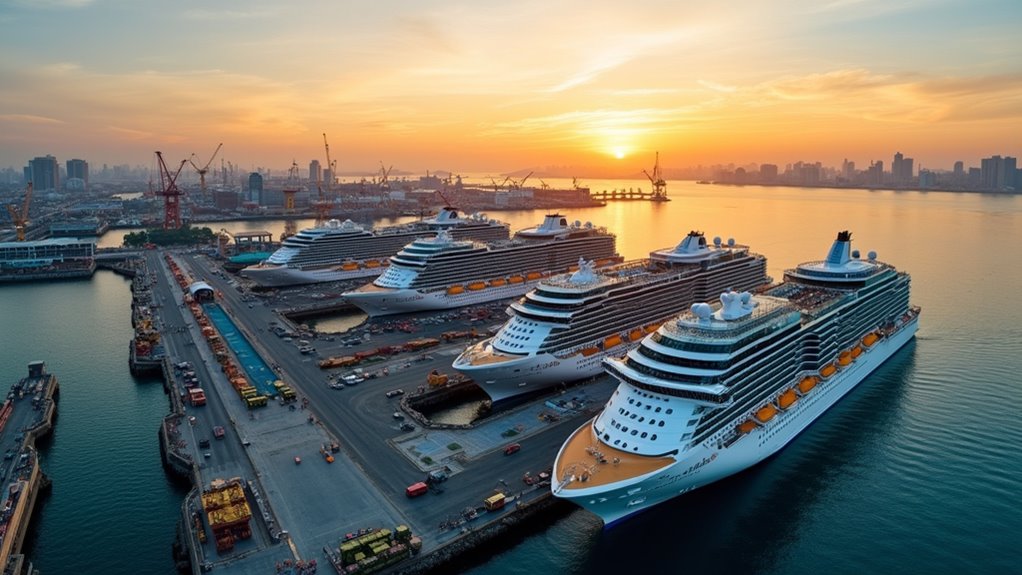
In 2025, the global cruise fleet is set to expand considerably, adding approximately 250,000 new berths and supporting a capacity nearing 704,200 passengers. This growth results from newbuilds arriving this year, contributing nearly 40,000 guest berths, and increases the fleet to about 370 ships. With a total orderbook value of $47.6 billion, the investment reflects strong industry confidence. As ships grow larger, over 20,000 crew members will be needed to operate these vessels efficiently. Passenger capacity forecasts suggest steady growth, with worldwide numbers reaching around 704,200 and industry projections indicating 37.1 million travelers in 2025—exceeding pre-pandemic levels. These developments mark a significant step in the cruise industry’s ongoing recovery and expansion. Additionally, the industry is increasingly emphasizing passenger safety and sustainable practices to meet evolving traveler expectations. The industry’s focus on ship design and technology advancements is also key to supporting this growth.
San Juan Cruise Port Modernization and Passenger Growth
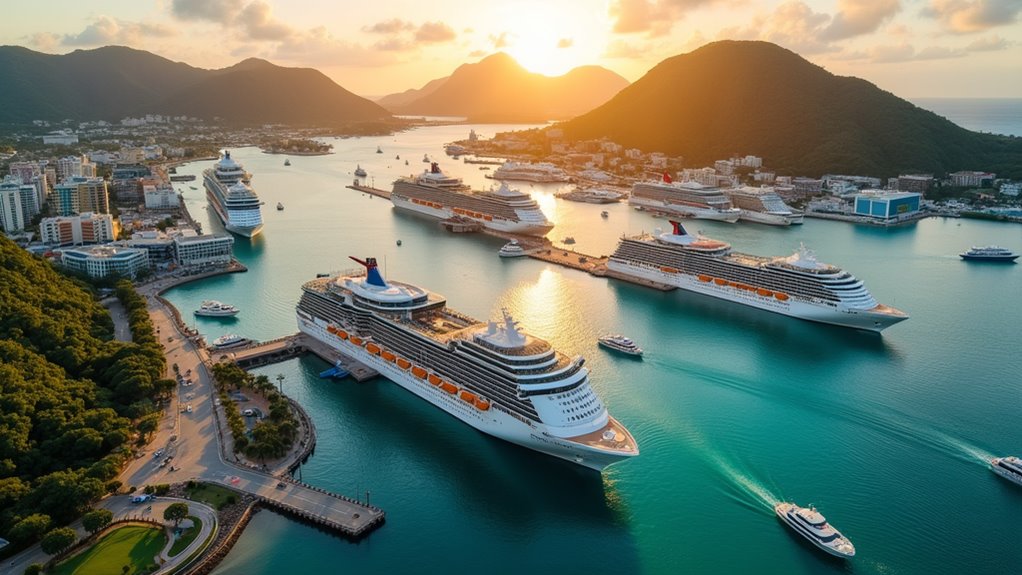
San Juan Cruise Port is making significant strides in modernization, with approximately 15.95% of the project completed by early May 2025. With a $425 million investment, the redevelopment aims to position SJCP as a top global cruise hub. Since operations began under new management in February 2024, infrastructure upgrades focus on safety, efficiency, and accommodating larger ships. Key improvements include Pier 3 West enhancements and mooring dolphin replacements. As a result, passenger capacity is set to expand, supporting increased cruise line activity and boosting tourism. The port’s growth reflects Puerto Rico’s economic ambitions, fostering local business and global competitiveness. Additionally, the project considers future investment opportunities to further enhance the port’s capabilities. Incorporating space optimization strategies can maximize the effectiveness of the upgraded infrastructure and improve overall passenger experience. The port’s development also emphasizes sustainable practices to ensure long-term environmental benefits. Emphasizing modernization efforts demonstrates the port’s commitment to staying competitive in the evolving cruise industry. Furthermore, ongoing technology upgrades are expected to streamline operations and enhance passenger convenience. The table below summarizes key project aspects:
| Investment | Infrastructure | Passenger Goals |
|---|---|---|
| $425M | Pier 3 Modernization | Increased Capacity |
| 15.95% | Safety Upgrades | Larger Cruise Ships |
| 2022 PPP | Mooring Upgrades | Economic Growth |
| Feb 2024 Operations | Future Expansion | Tourism Boost |
Industry-Wide Trends and Future Capacity Projections
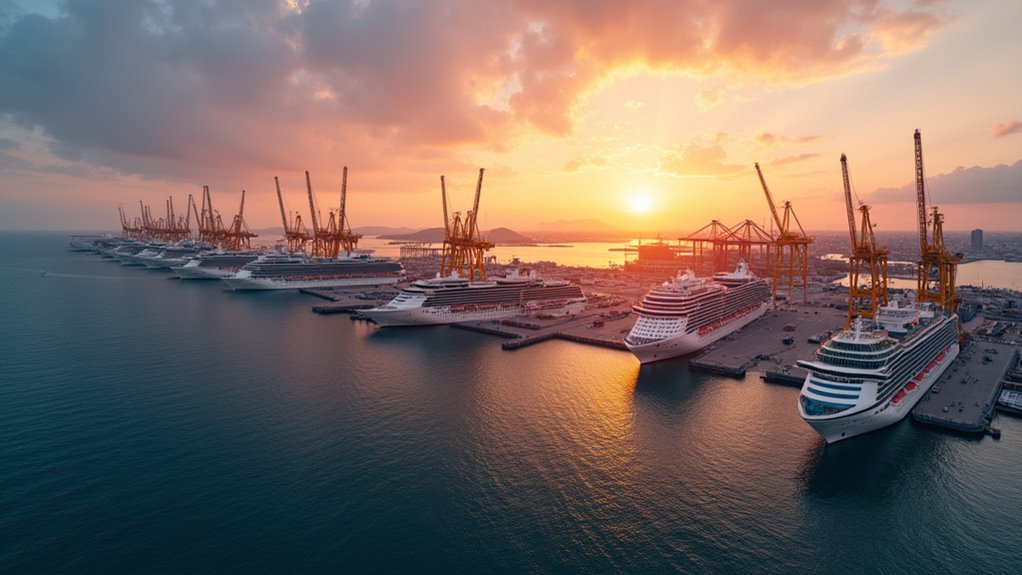
You’ll notice the cruise industry is expanding rapidly, with fleet upgrades and new ships fueling capacity growth. Projections show passenger numbers surpassing pre-pandemic levels by over 30% in 2025, indicating a strong demand rebound. As ports prepare for this surge, industry-wide trends point to sustained expansion and increased investment in infrastructure. Additionally, industry growth trends are driving innovation and modernization efforts across global cruise hubs. Furthermore, relationship-building exercises among industry stakeholders are fostering better collaboration and strategic planning for future growth.
Capacity Growth Trends
The cruise industry is experiencing robust capacity growth driven by expanding fleet sizes, technological innovations, and shifting consumer preferences. Global cruise capacity is forecast to grow at least 10% from 2024 to 2028, supporting a market projected to reach $53.49 billion by 2029. You’ll notice increased interest from younger travelers and families, boosting demand for more ships and diverse itineraries. New ships, like Royal Caribbean’s Utopia of the Seas, are contributing markedly to capacity expansion. Technological advancements improve ship efficiency and sustainability, enabling higher passenger volumes. Industry investments in cleaner fuels, shore power, and onboard experiences attract eco-conscious travelers, further driving growth. With strategic fleet deployments and a post-pandemic rebound, capacity will continue to rise, ensuring sustained expansion across regions and market segments. Additionally, implementing best practices in fleet management and operational efficiency can help optimize capacity utilization and support ongoing growth. The adoption of innovative maritime technologies is expected to enhance operational efficiencies and environmental compliance, further supporting capacity increases. Moreover, the integration of AI-driven insights into operational planning can optimize scheduling and resource allocation, contributing to higher capacity utilization. Recognizing the importance of professional help can also assist companies in managing rapid growth and overcoming operational challenges. Furthermore, the deployment of AI security measures can safeguard operational data and enhance cybersecurity as the industry expands its digital infrastructure.
Fleet Expansion Outlook
Industry-wide fleet expansion is accelerating as cruise lines prioritize sustainable and technologically advanced vessels to meet growing demand. You’ll see more ships designed with alternative fuels or zero-carbon options, aligning with industry sustainability goals. These vessels incorporate innovations to improve passenger experiences and operational efficiency. Expanding luxury offerings appeal to high-end travelers, while shorter itineraries and private islands boost capacity and frequency. Several new ships, like AmaMelodia launching in June 2025, are set to increase overall fleet size. Larger ships provide more passenger capacity, supporting record volumes expected through 2025. Technological advancements, such as digital personalization and efficient ship designs, further enhance onboard amenities and reduce costs. The integration of advanced propulsion systems is also expected to significantly lower emissions and operational expenses. Additionally, the adoption of innovative shipbuilding techniques allows for faster construction and greater customization of vessels. The integration of Personality Traits in crew training and onboard interactions is also contributing to improved passenger satisfaction. Overall, the fleet’s growth reflects a strategic push toward eco-friendly, innovative, and versatile vessels to accommodate future demand.
Regional and Global Investment in Cruise Terminal Facilities
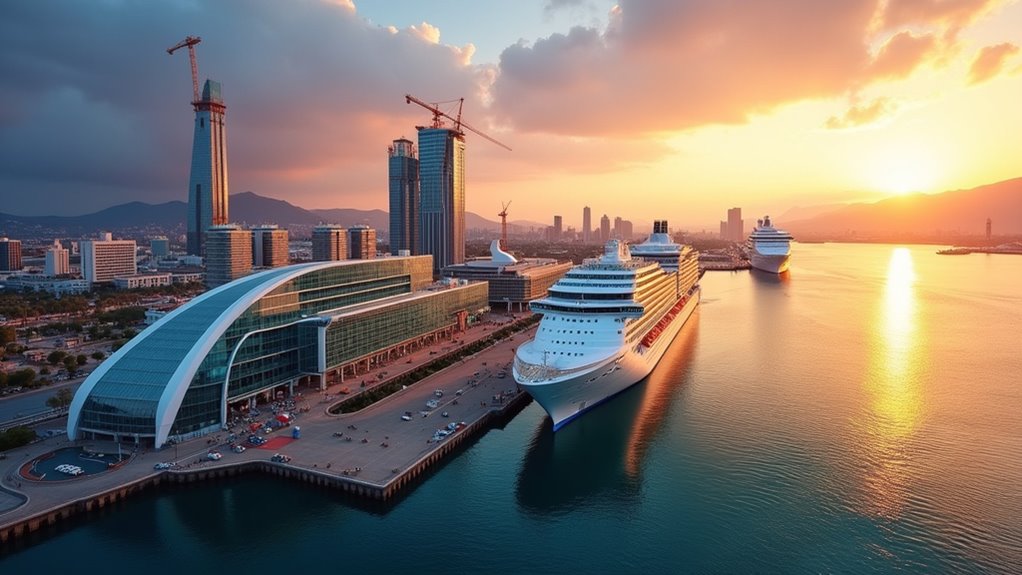
You can see that global investment in cruise terminal facilities is accelerating, with major operators like GPH expanding their port networks through extensive upgrades and capacity projects. These investments include modernizing infrastructure to handle larger ships and increasing passenger volumes, reflecting strong industry confidence. As regional and international funding continues to grow, ports are positioning themselves for sustained industry growth and economic impact.
Port Infrastructure Upgrades
Regional and global investments in cruise terminal facilities are accelerating as ports upgrade infrastructure to meet increasing demand and safety standards. You’ll see San Juan Cruise Port investing $42 million to improve operational efficiency and comply with new regulations, ensuring safer, smoother operations. At Port Canaveral, exterior upgrades at Cruise Terminal 1 include new canopies and walkways, enhancing passenger experience. Renovations also extend to the adjacent parking garage and gangways, boosting capacity and safety. The port’s safety measures include establishing a Cruise Automation Team to optimize boarding bridge operations. These upgrades support regional growth, like San Juan’s goal to become a key Caribbean hub, and reflect broader global trends, including port expansions and infrastructure improvements that prepare ports for larger ships and increased traffic.
Capacity Expansion Projects
Port Canaveral is making significant strides in expanding its cruise terminal capacity with a $500 million investment, including a 65% enlargement of Cruise Terminal 5 to host larger ships carrying up to 5,600 passengers. Exterior upgrades at Cruise Terminal 1 will begin in May 2025, featuring new canopies, walkways, landscaping, and lighting. A feasibility study for Cruise Terminal 10 is due by June 2025. The expansion of Terminal 5 is projected to take about 16 months without disrupting operations. This investment supports Port Canaveral’s goal to host the world’s largest cruise ships and handle over 8.4 million passengers annually. Here’s a snapshot of key projects:
| Project | Focus Area | Timeline |
|---|---|---|
| Cruise Terminal 5 | Capacity & infrastructure | 16 months from start |
| Terminal 1 Upgrades | Exterior enhancements | May 2025 |
| Terminal 10 Study | Feasibility & future expansion | June 2025 |
Global Investment Trends
The global cruise industry is experiencing a surge in investments, reflecting its robust growth prospects. You’ll see this in the projected $18.3 billion market value and the anticipated $29.76 billion expansion from 2025 to 2029, driven by economic recovery and rising numbers of High Net Worth Individuals. Ports worldwide are upgrading infrastructure, modernizing terminals, and investing in sustainable technologies to support larger ships and eco-friendly operations. Major hubs like U.S. ports, European ports such as Alicante, and Caribbean private islands attract significant funding. Companies like Global Ports Holding are expanding their port portfolios. These investments focus on capacity, sustainability, and technological advancements—ensuring ports stay competitive, handle mega-ships efficiently, and meet evolving consumer demands.
Economic Impact and Job Creation From Port Developments

Developments and expansions at cruise ports have become essential drivers of economic growth and job creation. In 2023, the global cruise industry’s impact reached $168.6 billion, with the U.S. contributing around $55 billion in 2019. Ports like PortMiami significantly boost local economies, with its economic impact climbing to $61.4 billion in 2023. These port upgrades increase capacity, attract more cruise lines, and support local businesses, creating thousands of jobs. In 2023, the cruise industry supported 1.6 million jobs worldwide, a 37% rise from 2019, with over 77% land-based. Job opportunities span sectors like hospitality, retail, and shipbuilding, fueling recovery and growth. As ports expand, they continue to play a crucial role in strengthening regional economies and supporting the industry’s ongoing global expansion.
Frequently Asked Questions
How Will New Terminal Projects Affect Cruise Passenger Experience?
You’ll notice that new terminal projects improve your cruise experience by offering more space, modern amenities, and better crowd management. These upgrades mean shorter wait times, smoother check-ins, and more comfortable waiting areas. Enhanced security, upgraded lounges, and clearer signage make steering easier. Overall, these improvements help create a more enjoyable, efficient start and end to your cruise, making your journey more relaxing and memorable.
What Environmental Considerations Are Involved in Port Expansion Projects?
You might think port expansions are just about adding new terminals, but they’re actually a battlefield for the environment. You’re involved in reducing air pollution, managing wastewater, and cutting noise to protect marine life. Eco-friendly measures like habitat restoration, renewable energy, and banning plastics are essential. By prioritizing these, you help guarantee growth doesn’t come at the planet’s expense, creating a sustainable future for cruise tourism and ecosystems alike.
How Are Ports Preparing for Larger Cruise Ships in the Future?
You’re curious about how ports are preparing for larger cruise ships. They’re investing heavily in infrastructure upgrades, like expanding terminals and modernizing piers, to handle bigger vessels safely and efficiently. Ports also strengthen maritime infrastructure and collaborate with private partners to improve operations. These efforts aim to boost capacity, enhance passenger experience, and support future growth, ensuring ports can accommodate the increasing size and demand of cruise ships.
What Safety Measures Are Being Implemented During Infrastructure Upgrades?
You should know that during infrastructure upgrades, safety measures focus on safety-centric design and strict safety protocols. You’ll see modernized facilities built to handle larger vessels safely, along with enhanced mooring systems. Construction sites follow rigorous safety protocols, use visible warning systems, and conduct regular inspections. Emergency plans and safety equipment are in place, while monitoring systems and maintenance guarantee ongoing safety. Feedback from users helps continuously improve safety standards at the port.
How Do Port Developments Impact Local Communities and Tourism?
Imagine your community celebrating a new port that brings more visitors and jobs. Port developments boost local economies by increasing tourism, creating employment, and supporting small businesses. They improve infrastructure, making travel smoother and more attractive for cruise lines. Plus, community-focused projects enhance quality of life and promote environmental sustainability. Overall, these developments offer more opportunities, richer experiences, and a stronger, more vibrant local community for you to enjoy.
Conclusion
As you look at these developments, it’s clear the cruise industry is booming, transforming ports into bustling hubs of activity. With new terminals, fleet upgrades, and global investments, your travel experiences will only get better. Can you imagine stepping into a modern port that feels more like a destination itself? The future of cruising promises bigger ships, more routes, and exciting adventures — all waiting just beyond the horizon.

